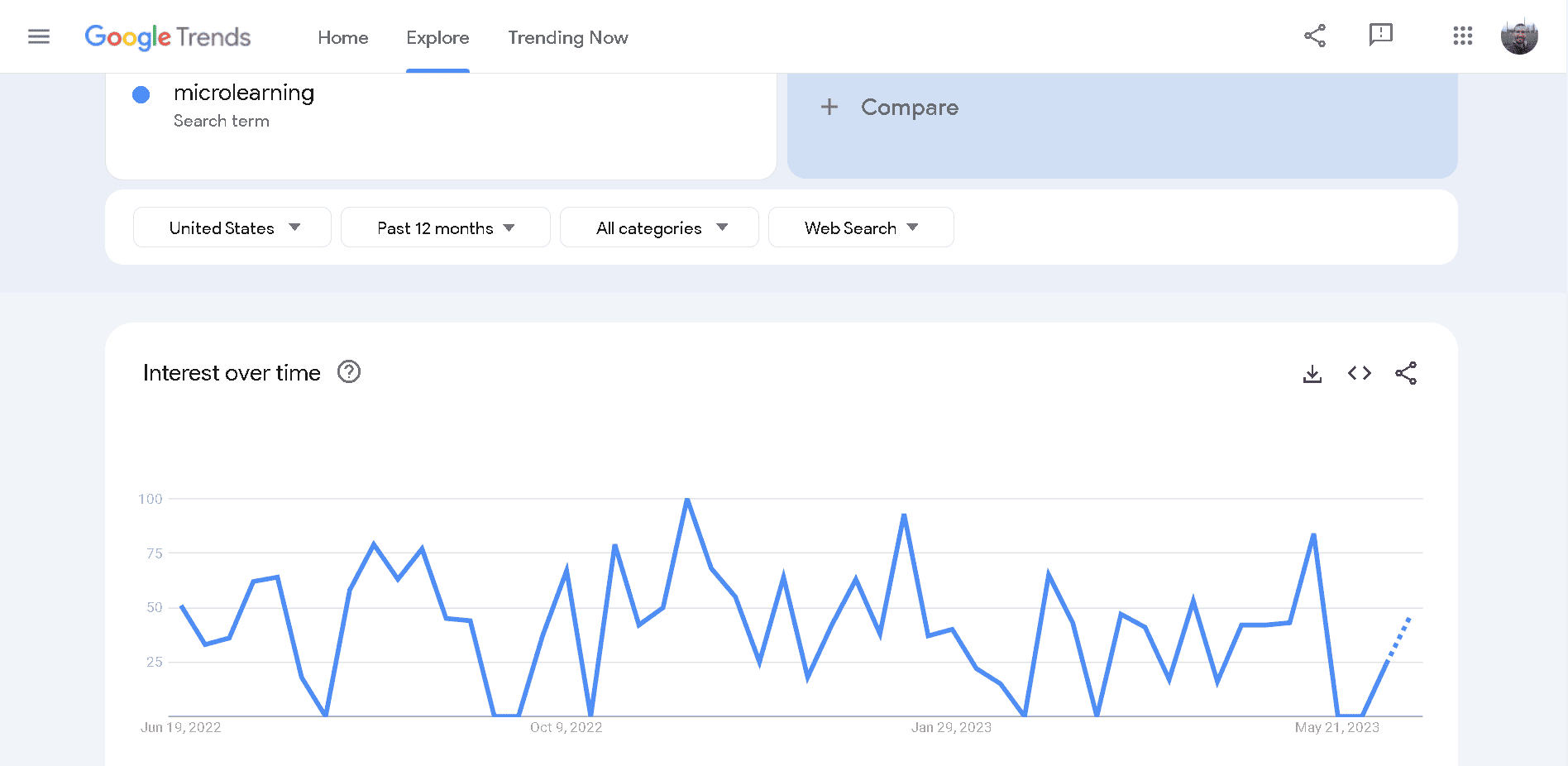Disclosure: Some of the links you’ll encounter are affiliate links. If you click and buy something, I’ll get a commission. If you’re reading a review of some precious metals company, please understand that some of the links are affiliate links that help me pay my bills and write about what I love with no extra cost to you. Thank you!
Looking for the latest microlearning statistics facts and trends for 2024?
My updated guide has everything you need, and more.
Feel free to use these jump links to go to the section that interests you the most.
Also, all the references and resources I used in crafting my microlearning stats are listed at the bottom of the page.
Let’s go!
Jump here: Key Microlearning Statistics Facts and Trends for 2024|Corporate Microlearning Stats Facts and Trends for 2024|Microlearning Trends 2024|Microlearning Statistics Facts and Trends for 2024 FAQ|Conclusion|

Table of Contents
Key Microlearning Statistics Facts and Trends for 2024
- A 10-minute microlearning course has a completion rate of 83%, compared to 20% to 30% for standard learning and development courses.
- Microlearning is proven to boost retention rates by anywhere from 25% to 60%.
- Microlearning courses have high completion rates, ranging from 70% to 80%.
- The majority of workers (80%) favor microlearning over conventional learning strategies.
- Microlearning is 5–10 times more effective than conventional learning techniques in terms of efficiency.
- The use of microlearning has a beneficial effect on staff productivity, according to more than half (53%) of the organizations surveyed.
- Microlearning is commonly done via mobile devices. Because the learning sessions are often short, learning can be done on the go and mobile phones help a ton here.
Best Microlearning Statistics Fact and Trends for 2024 (Full Breakdown)
Interesting Microlearning Statistics Trends and Facts 2024
What Does the Research Suggest About Microlearning and Employee Focus and Long Term Retention?
Research suggests microlearning boosts employee focus and long-term retention by 80%.
Is Microlearning More Efficient Compared to Traditional Courses in 2024?
Microlearning is 17% more efficient compared to traditional courses and learning methods.
Does Microlearning Boost Employee Engagement or Not?
Microlearning successfully boosts employee engagement from about 15% to 90%.
Do E-Learners Prefer Microlearning on the Job or Not?
94% of e-learners surveyed prefer microlearning on the job, however, 65% of them indicate their organizations’ courses are too bulky and contain too much information.
Corporate Microlearning Stats Facts and Trends for 2024
Are Employees in 2024 More Motivated to Learn and Improve Their Skills and Knowledge?
Employees in 2024 are motivated to learn and improve their skills and knowledge.
58% of them claimed in a survey they’d spend more time honing their skills at work if only the content is presented in shorter, more snackable chunks.
Do E-Learning Trainers in 2024 Prefer Microlearning Over Day-Long Seminars or Not?
In 2024 95% of E-learning trainers surveyed claimed they prefer microlearning to day-long seminars simply because the learners enjoy it much more and the atmosphere is better.
Are Employees in 2024 Even More Overwhelmed by the Amount of Information Presented in Traditional Training Courses?
In 2024 65% of employees are even more overwhelmed by the amount of information presented in traditional training courses.
Can Microlearning Lower Development Costs?
Microlearning can lower development costs by 50%.
Can Microlearning Increase Development Speed?
Microlearning can increase development speed by 300%.
What Percentage of Employees are More Likely to Use Online Learning Tools?
58% of employees are more likely to use different online learning tools if they can learn to operate them via using microlearning strategies such as multiple shorter modules.
Microlearning Trends 2024
Here are some microlearning trends that will dominate in 2024 and beyond.
- Customization is going to be key for effective microlearning. One size fits all training is no longer effective.
- Microlearning courses are going to focus more on emphasizing people skills and closing the digital skills gap as fast as possible
- An important microlearning trend in 2024 is giving the opportunity to professionals to develop learning experiences that allow them to attain proficiency as quickly as possible. That’s where Microlearning fits the bill.
- An increasing percentage of employees are going to see training, including microlearning, as job benefits and are increasingly going to look for opportunities to hone their skills and grow their knowledge.
Microlearning Statistics Facts and Trends for 2024 FAQ

#1- What is Microlearning?
Microlearning is a learning method that’s all about teaching small bits of skill and knowledge to individual employees at just the right time.
It’s a way for modern businesses to keep updated their employees’ skills and knowledge in an ever-changing world.
#2- How Long is an Optimal Microlearning Lesson?
An optimal microlearning lesson is 7-12 minutes long.
#3- What is the Average Completion Rate of a Microlearning Course?
The average completion rate of a microlearning course is 83%, which is a drastic improvement over 20-30% which is the average completion rate for a macrolearning course.
#4- How Much Do Microlearning Training Programs Cost?
Microlearning training program cost from $4 and upward.
Some microlearning training programs offer a free plan for up to a certain number of users or a free trial.
#5- Why is Microlearning a Trend?
Microlearning is a trend because it lets busy people improve their skills and knowledge at their own pace.
Microlearning as a learning method is effective because learning is done in small chunks and no matter how busy, everyone can carve out 15m of their busy day to absorb some new knowledge.
Especially if that new info will help them become more successful at their work.
#6- Is Microlearning Cost Effective?
Microlearning is cost effective because it has been proven that people learn 5-10 times better than with traditional learning methods.
#7- Is Microlearning Trending in 2024?
Microlearning is not trending in 2024.
As you can see from the Google Trends graph below, the interest ebbs and flows but is also constant.
Microlearning as a topic is evergreen, but the amount of interest in it varies.
#8- What are the Best Microlearning Companies?
The best microlearning companies are:
- Grovo;
- Axonify;
- EdApp;
- TalentCards;
- Qstream.
#9- What is the Value of Microlearning?
The value of Microlearning is that employees can gain new skills while still doing their usual work on a daily basis. Microlearning is a way to stay in touch with the latest technologies and trends.
#10- What are the Key Statistics for Microlearning in 2024?
Please click this link to read the key statistics for microlearning in 2024.
Best and Latest Microlearning Statistics, Facts and Trends in 2024 #microlearning #stats #statistics #facts #trends Click To TweetBest Microlearning Statistics Facts and Trends for 2024 (Conclusion)
My updated guide lists the best and latest microlearning statistics facts and trends for 2024.
I hope you enjoyed it because the guide is now over.
During my research, I consulted these resources below:
References:
- Seven Statistics that Prove the Value of Microlearning for Corporate Training
(https://www.lmsportals.com/post/seven-statistics-that-prove-the-value-of-microlearning-for-corporate-training) - Numbers Don’t Lie: Why Microlearning is Better for Your Learners (https://www.shiftelearning.com/blog/numbers-dont-lie-why-bite-sized-learning-is-better-for-your-learners-and-you-too)
- 4 eye-opening statistics that reveal the value of microlearning for company training
(https://axonify.com/blog/important-microlearning-statistics/) - What is the appropriate length of a microlesson
(https://www.edapp.com/blog/what-is-the-appropriate-length-of-a-microlesson/) - Microlearning best practices (https://www.dashe.com/blog/microlearning-best-practices-revolutionizing-your-training-in-2022) Note- this page is gone now, but I did use it as a resource when creating my Microlearning stats page.
- Understanding the Power of Microlearning and its Appeal to Learners
(https://www.prnewswire.com/news-releases/understanding-the-power-of-microlearning-and-its-appeal-to-learners-301594833.html) - How to Achieve 90% Course Completion Rates (3 Data-Driven Insights)
(https://360learning.com/blog/90-course-completion-rates/) - 13 Insightful Microlearning Stats 2024 [Facts and Trends] (https://thrivemyway.com/microlearning-stats/)
- Maximizing eLearning Impact: 5 Microlearning Platforms For 2024
(https://blog.commlabindia.com/elearning-design/microlearning-platforms-maximize-impact-elearning)
Nikola Roza
Nikola Roza is a blogger behind Nikola Roza- SEO for the Poor and Determined. He writes for bloggers who don't have huge marketing budget but still want to succeed. Nikola is passionate about precious metals IRAs and how to invest in gold and silver for a safer financial future. Learn about Nikola here.


Hi Nikola, I love learning this way! I can’t stand an hour-long course. I actually teach some to real estate agents and I try to make them shorter and break them down into pieces. People cannot pay attention for that long today. It makes it harder for them to retain the info as well.
Exactly right, Lisa!
Microlearning, and learning in bits and pieces is what most humans prefer.